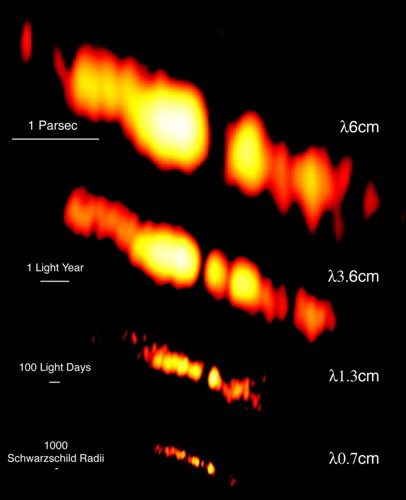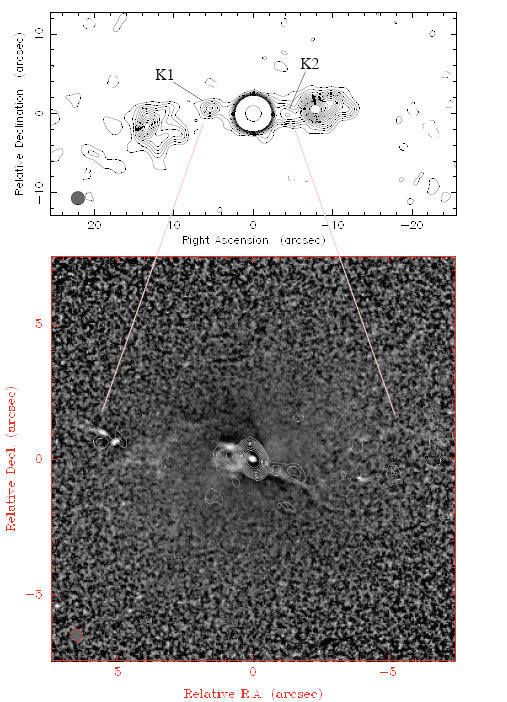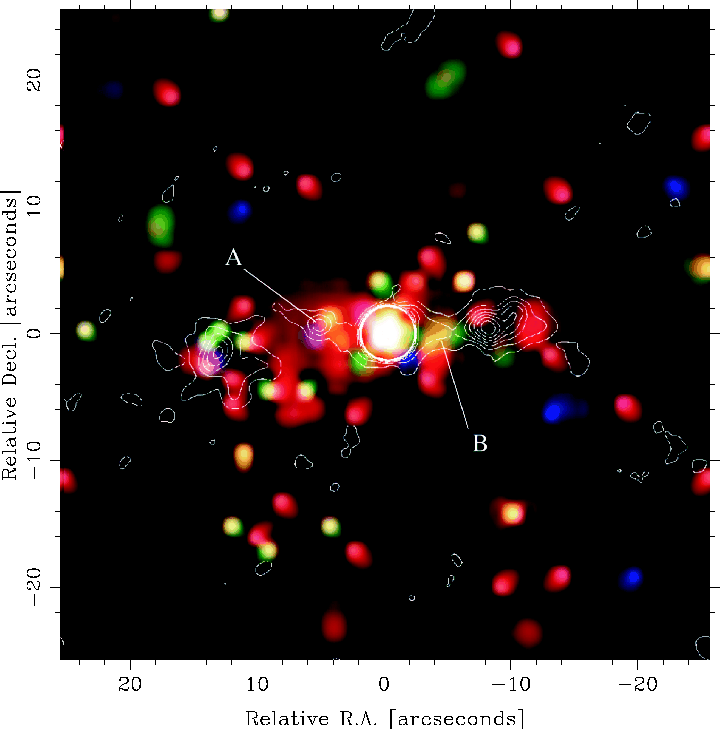| VLBI Monitoring of Relativistic Jets in AGN |
A
multiwavelength
Study of NGC1052 |
The Origin of Gamma-Ray Flares in AGN Jets | Image & Movie Gallery |
|
A
Multiwavelength Study of NGC1052
|
|
| Part 1: A
VLBI and Multiwavelength Scrutiny |
Part
2: Jet-Disk Coupling |

Spinning the Wheel on NGC1052, M. Kadler, E. Ros, Contribution to the NRAO Image Gallery
Movie:
Zooming into the nucleus of NGC1052
The jet and counterjet are aligned with an optical emission cone, made visible here against the surrounding star light of the host galaxy via structure mapping (Pogge et al. 2002). The dark band perpendicular to the radio jet might be an artifact of the image processing or might alternatively represent the signature of an obscuring dusty region. The two optical emission knots in the east are located at the edges of two radio sub-components of knot K1. The optical emission knot in the west coincides roughly with a weak (~1 sigma) radio feature while the stronger radio knot 1.5 arcsecond further out (K2) has no corresponding bright optical counterpart. Both knots, however, coincide positionally with an uncertainty of 4 arcsec with X-ray knots in the jet structure (see below). The origin of the optical emission remains unclear since there is no continuum image to subtract from the H filter image of NGC1052. The morphological similarity of the emission cone in this LINER 1.9 galaxy to the features typically observed in Seyfert 2 galaxies (Falcke et al. 1998), however, suggests an origin in the narrow emission line region. The optical flux density of the two eastern knots of (68±1) μJy exceeds the powerlaw extrapolation from the radio to the X-ray regime by almost three orders of magnitude ruling out synchrotron emission as a possible mechanism.

We also analyzed archived Chandra data from a short (2.3ksec) snapshot observation of NGC1052 and found a X-ray jet associated with the well known radio jet. The Chandra data provide also further constraints on the properties of the circumnuclear absorber in NGC 1052. Imaging the extended X-ray emission reveals the presence of various jet-related X-ray emitting regions in NGC 1052: a bright compact core, unresolved knots in the jet structure, and an elongated, diffuse emission region whose spectrum can be described by a thermal model.

Download my Diploma Thesis
Complete
Thesis (gzipped ps-file, 6.7Mb)
Chapter
1 (gzipped ps-file: 2.5Mb)
Introduction to AGN and the unified scheme, a small gallary of radio
and X-ray jets, NGC1052 the star of the show
Chapter
2 (gzipped ps-file: 90kb)
Theoretical background: Synchrotron and inverse Compton radiation,
Jet emission, Core shift
Chapter
3 (gzipped ps-file: 0.7Mb)
Fundamentals of radio aperture synthesis, VLBA observations of NGC1052,
VLBI data reduction:
a-priori calibration, fringe fitting, total intensity mapping,
feed calibration
Chapter
4 (gzipped ps-file: 1Mb)
Results: Total intensity mapping, Model fitting and image alignment,
Spectral analysis,
Brightness temperature distribution, Polarimetry, Core shift analysis
Chapter
5 (gzipped ps-file: 50kb)
The big picture: A very simple model for the nucleus of NGC1052
Appendices
(gzipped ps-file: 2.1Mb)
Single dish spectrum, MERLIN and CHANDRA observations, NGC1052 on
kpc-scales
in the radio regime,
Xray results
